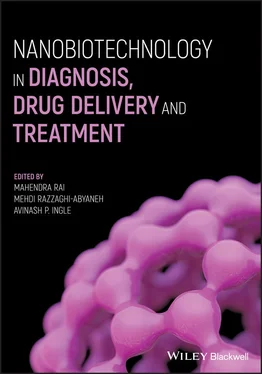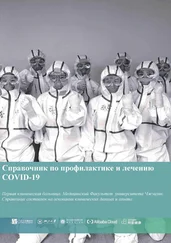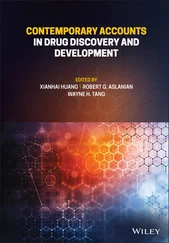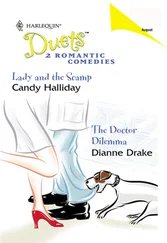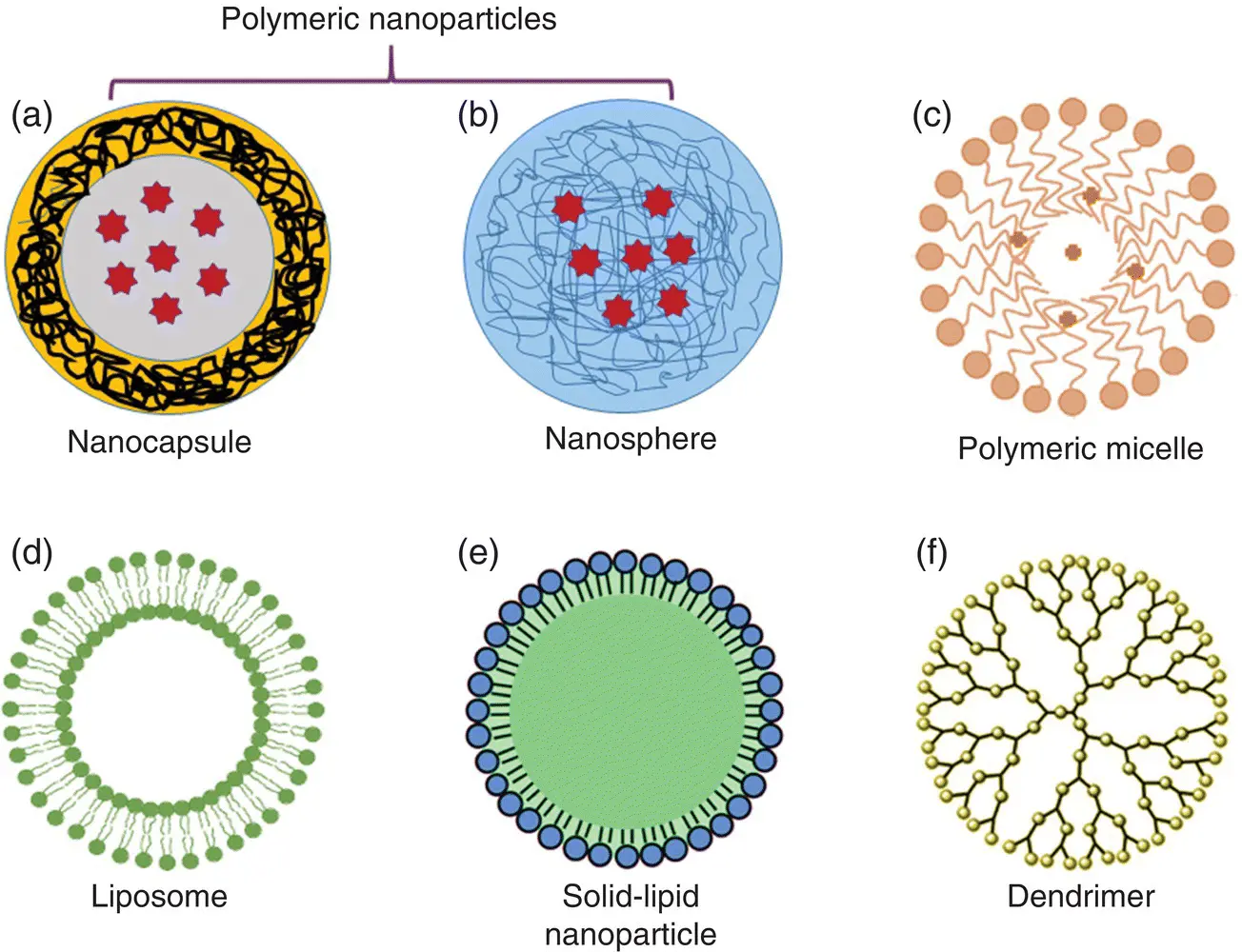
Figure 1.2 Schematic representation of various organic nanomaterials.
1.2.2.2 Polymeric Micelles
Polymeric micelle ( Figure 1.2c) is the class of organic nanomaterials usually formed by the spontaneous arrangement of amphiphilic block copolymers in aqueous solutions (Kulthe et al. 2012). Structurally these nanomaterials are composed of the hydrophobic core and hydrophilic shell, which facilitates the loading of various hydrophobic drugs like camptothecin, docetaxel, paclitaxel, etc. into the core to be used as nanocarriers (Singh et al. 2019). The encapsulation of drugs in polymeric micelles enhances their solubility. Various novel properties of polymeric micelles, including their small size, make them promising nanocarriers in drug delivery. Polymeric micelle‐mediated drug delivery showed many advantages like easy penetration, target‐specific drug delivery, narrow distribution to avoid fast renal excretion, etc. Moreover, polymeric micelles can also be conjugated with targeting ligands which facilitates their uptake by specific cells, thus reducing off‐target side effects. Polymeric micelles can be synthesized using two different approaches: (i) convenient solvent‐based direct dissolution of polymer followed by dialysis process; or (ii) precipitation of one block by adding a solvent (Patra et al. 2018).
The word liposome ( Figure 1.2d) has been derived from the two Greek words: lipo (“fat”) and soma (“body”), and was described for the first time by British hematologist Alec Bangham in 1961, at the Babraham Institute, in Cambridge (Bangham and Horne 1964). Liposomes are among the group of organic nanomaterials which are comparatively small, spherical vesicles that are amphipathic (contains both hydrophilic and hydrophobic structures). Liposomes are generally composed of phospholipids and spontaneously formed when certain lipids are hydrated in an aqueous media (Singh et al. 2019). The unique structure of liposome (i.e. lipid bilayer[s] structure) facilitates the incorporation of both hydrophilic and hydrophobic drugs, which helps to prevent the rapid decomposition of the incorporated drug and also to release the drug molecules at a specific targeted site (Lujan et al. 2019). Liposomes reported having several promising properties such as small size, lipid bilayer structure, surface charge, biocompatibility, biodegradability, low toxicity, site‐specific delivery, etc. Due to all these properties, liposomes have attracted a great deal of attention from researchers all over the world for their use as potential drug delivery systems in various diseases including cancer (El‐Hammadi and Arias 2019). Moreover, liposomes have been modified to develop some other phospholipid vesicles which selectively have their applications in the delivery of specific drugs or biomolecules (mostly for transdermal delivery). These vesicles mainly include transferosomes, niosomes, and ethosomes.
Transferosomes are the modified form of liposomes which are considered to be highly elastic and deformable. These modified forms of liposome were developed by Gregor Ceve for the first time in 1990 (Blume and Ceve 1990). Transferosomes are almost similar to liposomes in their basic structural arrangement; the only difference is that the outer layer of transferosomes is more complex in nature compared to liposomes. These nanomaterials reported having enhanced flexibility due to edge activator presence in lipid bilayer (Abdallah 2013). Usually, transferosomes are formed by self‐controlled assembly and they are efficient to cross the various transport barriers, and hence are selectively used as carriers for the delivery of drugs and other macromolecules instead of liposomes (Sharma 2019).
Niosomes are another kind of liposomes that are supposed to be osmotically active, highly flexible, and comparatively more stable than liposomes (Bartelds et al. 2018; Sharma 2019). These nanomaterials are mainly composed of nonionic surfactants like alkyl ethers, alkyl glyceryl ethers, sorbitan fatty acid esters, and polyoxyethylene fatty acid esters stabilized by cholesterol (CH) (Muzzalupo and Mazzotta 2019). Like liposomes, they also form a lamellar structure in which the hydrophilic heads have oriented outward and the hydrophobic tails point inward or facing the opposite direction to form a bilayer (Sharma 2019). Niosomes are economically viable nanomaterials compared to liposomes and other related nanomaterials; moreover, they possess various novel properties such as their biodegradable, biocompatible, and non‐immunogenic nature (Singh et al. 2019).
Ethosomes are also a type of phospholipid vesicles, considered a modified form of liposome mainly composed of ethanol, phospholipids, and water. In addition, some other components can also be included in ethosomes for specific characteristics e.g. polyglycol as a permeation enhancer, cholesterol to increase the stability, and dyes useful for characterization studies (Sharma 2019). These vesicles for the first time were developed by Prof. Elka Touitou around 1997. The simple synthesis process, high efficacy, and nontoxic nature of ethosomes allowed their use in widespread applications related to transdermal delivery. Ethosomes are soft, malleable vesicles tailored for enhanced delivery of active agents (Verma and Pathak 2010). Ethosomes are noninvasive delivery nanocarriers that facilitate penetration of drugs deep in the skin layers and the systemic circulation, and are reported to have higher transdermal flux than liposomes (Godin and Touitou 2003). The presence of ethanol in higher concentrations makes the ethosomes novel and unique, as ethanol is known for its disturbance of skin lipid bilayer organization.
1.2.2.7 Solid Lipid Nanoparticles (SLN)
SLNs ( Figure 1.2e) are among the class of lipid nanoparticles having a size in the range of 1–1000 nm, usually have a crystalline lipid core which is stabilized by interfacial surfactants (Sun et al. 2019). These nanomaterials were introduced in 1991 for the first time. SLN are reported as having various novel properties such as easy synthesis, low cost, ability to store various molecules/drugs with high loading capacity, controlled drug release, improved stability, improved biopharmaceutical performance, etc. Therefore, SLN have been preferably used over the other various drug delivery systems like emulsions, liposomes, and polymeric nanoparticles (Pink et al. 2019).
Dendrimers ( Figure 1.2f) are highly branched three‐dimensional nanomaterials consisting of polymeric branching units attached to a central core through covalent bonding, which are organized in concentric layers and that terminate with several external surface functional groups (Lombardo et al. 2019). Dendrimers are synthetic nanomaterials fabricated by a specific synthesis approach involving a series of different reactions that allow precise control on various parameters like size, shape, and surface chemistry which result in highly monodisperse nanostructures. Like various other nanomaterials described above, it is possible to conjugate suitable drugs or macromolecules like proteins or nucleic acid into the surface of dendrimers in order to use them as potential nanocarrier (Virlan et al. 2016). Dendrimers reportedly enhance the solubility and bioavailability of hydrophobic drugs that are entrapped in their intramolecular cavity or conjugated on their surface. However, various factors such as surface modification, ionic strength, pH, temperature, etc., influence the structural properties of dendrimers (Choudhary et al. 2017). Figure 1.2represents the schematic illustration of various organic nanomaterials.
Читать дальше
